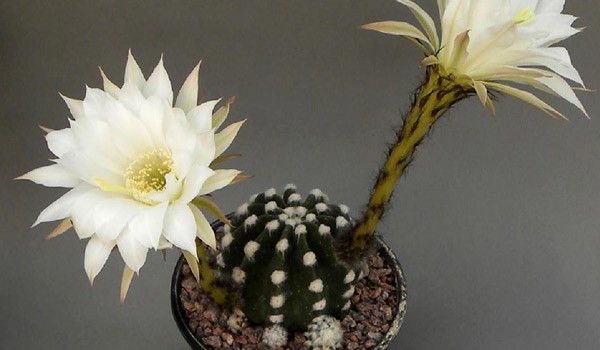Echinopsis Cactus (Sea Urchin Cactus) Full Guide

Looking for symmetrical cactus with gorgeous flowers to add to your succulent collection? The Echinopsis cactus may be the one. Also known as the Easter lily cactus, Sea Urchin cactus, Sea cactus, Hedgehog cactus, and sometimes Torch cactus (Trichocereus) this beautiful plant comes from South America.
In the next part of this article, you’ll find a complete Echinopsis Cactus guide, from reviewing different Echinopsis species, to how to grow them, what their requirements are, etc.
Echinopsis Species & Types
There are many Echinopsis Cactus types that are different in forms and the color of their flowers. Before naming some of the famous Echinopsis species, it’s good to know that Trichocereus and Lobivia generas are included with Echinopsis.
As partly mentioned, you can see people use Trichocereus or Lobivia to refer to this plant; the first one for the large and columnar ones, and the latter for smaller ones with fewer spines and blooms that appear from low.
The main similarity among these plants is their very large and eye-catching flowers. The blooms are very similar in their funnel shape, which later turn into globular fruits with mushy pulp. Depending on the Echinopsis species, the flowers are diurnal or nocturnal and have a short life.
Hybridizing the Sea Urchin cactus is considerably convenient, which translates into a tremendous number of hybrids (more than 130 types). Some of the Sea Urchin cactus varieties that are more common for cultivation include:
- E. antezanae
- E. bolligeriana
- E. candicans
- E. glaucina
- E. klingleriana
- E. marsoneri
- E. pentlandii
- E. rhodotricha
- E. spiniflora
- E. thelegona
- E. tiegeliana
- Etc.

Hybrid Echinopsis Cactus Care
Due to their exceptional (and slightly fragrant) white or pink flowers, growing the Hedgehog cactus is actually very popular among both beginner and professional gardeners. They can give a nice view to any garden, collection, or landscape.
But don’t let it scare you, a hybrid Echinopsis cactus is easy to grow and gives you the famous flowers of this family. Since they grow in a wide range of habitats and climates throughout South America, it’s not very challenging to keep them healthy and happy.
Watering
The Sea Urchin cactus is a types of succulent; so it doesn’t need a lot of water and prefers a drying period after watering. So let the soil mix to almost dry out between each irrigation. But when you want to water it, do it thoroughly. Also, make sure immaculate drainage for the plant, and do not let it sit in excess water.
Remember that the frequency of watering your Echinopsis Easter lily cactus depends greatly on the type of soil mix, weather, and the pot (both size and material). The Sea cactus needs more water in hot summers, which is also its blooming season.
In colder seasons, it will be dormant or semi-dormant. So suspend watering and mist occasionally. If you feel your plant doesn’t glow as before, spray it with water.
To ensure correct watering, stick a pencil into the pot and check the water on its surface. If the surface comes out with little to no water, it is time to water the plant.
Light & Temperature
Similar to other cacti and succulents, the Echinopsis cactus prefers strong light (not full sun) during the growing season. If it’s possible, place it outdoors in this period. However, let it adapt to direct sunlight slowly so its leaves don’t scorch. In cold seasons, we recommend southern exposure.
In the winter, and when your Sea Urchin cactus is dormant, the ideal temperature for it is 50° to 55° degrees Fahrenheit. In the spring, don’t forget to move it to a warmer spot.
Soil & Fertilizer
A hybrid Echinopsis cactus would love a well-drained and rich soil mix. DIY cactus mix or cactus and succulent soil mixes are good choices too. We recommend feeding your Hedgehog cactus with a cacti fertilizer during its growth period (and not cold seasons) for the best result.
Repotting & Grooming
Warm months are the best time to transplant Echinopsis Cactus types. When the soil is dry, carefully separate the plant from the pot, and remove rotting or dead roots. Also, treat the cuts using a fungicide.
After placing the cactus into the new pot with fresh soil (while spreading the roots), don’t water it for a week to minimize the risk of root rot. After this time, begin caring and watering as before.
Tips: The Sea cactus has stiff spines; so wear gloves and be careful when handling it.
There is almost no need for maintenance. This trouble-free simply needs correct watering to bloom without any problem.
Pest & Diseases
As you can guess, the Echinopsis Easter lily cactus is generally free of pests and diseases. The only thing that you need to keep an eye out for, is the infamous root rot.

Sea Urchin Cactus Propagation
If you look at pictures of Echinopsis Cactus (mature ones), you can see the offsets that cluster around the base of the mother plant. You can root these little offsets easily following the steps below:
- Cut offsets close to the stem, at the narrowest place.
- Place the cutting on a paper towel and let it dry out slightly and form a callus for a few days. The cutting may need more time for this process, depending on the size of the cut surface
- When the callus is formed, place the Trichocereus cutting in a fast-draining cactus soil mix.
- Place it in a warm location and keep the cutting barely moist.
- After a few weeks, roots will form around the vascular bundles or the areoles near the cut.
When you can see the new roots, simply pot the young cactus and place it where you like.
- In this post:
- Echinopsis Species & Types
- Hybrid Echinopsis Cactus Care
- Sea Urchin Cactus Propagation



